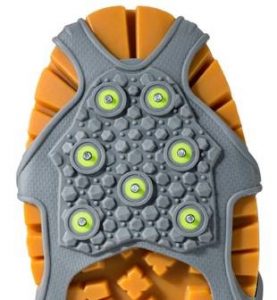On my way into the city one day last year, the skies began to grow dark and by the time I pulled into the parking lot, the heavens had opened up and were dumping buckets of water all around me. From inside my car, I could see that some enterprising young fellow had opened up a makeshift umbrella sales stand on the corner. Not wanting to arrive to my appointment soaking wet, I parked my car, made a mad dash to his stand and gladly forked over the $20 for the small black umbrella.
Continue Reading
As a safety manager, this is the time of year your attention turns to winter prep. Storms are right around the corner and reducing winter slips and falls is sure to be on your mind. So, have you started your search for the perfect ice cleat or traction aid? And if so, have you made your decision on whether to use replaceable or permanent spikes. If you’re still making that choice, here’s some info that may help. Replacing spikes in traction footwear is indeed a cost-saving option. It allows you to re-use existing footwear for just a few dollars a pair.
Continue Reading
If you’ve tried to introduce a new piece of PPE to your workforce, you know how hard it is for humans to change their ways. I talk to a lot of safety managers to discuss ice cleats and traction aids for shoes and they all tell me some version of: “I know my guys. They’ll never bother to put them on.” But if you’re a safety professional who knows that wearing ice cleats will reduce the number of winter slip and fall injuries (and, in the process, increasing your company’s workers comp claims), then you owe it to your company, your work staff and yourself to find a way to introduce an ice tracti[…]
Continue Reading
Far and away, the most common complaint we hear is that people hate taking their ice cleats on and off throughout the day, especially when they walk from outside to inside frequently. Who can blame them? Winter slips and falls on snow and ice are often the number one cause of recordable incidents. While ice cleats seem like an obvious solution to reduce accidents, there are two realities that complicate the issue:
Continue Reading
So let me ask you a rather blunt question: Why are your employees using the Personal Protective Equipment (PPE) they are today? Chances are, your company has a lot of PPE footwear standards that are mandatory, not voluntary, as a condition of employment. What about safety glasses, hard hats, steel-toe boots, high-visibility clothing, fire-retardant apparel?
Continue Reading
If math frightens you, don’t worry. I’ll try to make this as painless – and as helpful – as possible. As a safety professional concerned about your workplace safety record, you’re planning on buying traction aids for your employees. So, it is fair to consider whether the item you are purchasing is too expensive. While you would generally expect a company to spend whatever it takes to keep everyone as safe as possible, that might not always be the case. As a matter of fact, from a pure numbers standpoint, it might even make sense to let the accidents happen.
Continue Reading












